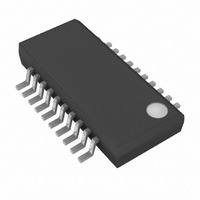MAX6697EP34+ Maxim Integrated Products, MAX6697EP34+ Datasheet - Page 14

MAX6697EP34+
Manufacturer Part Number
MAX6697EP34+
Description
IC TEMP MON 7CH PREC 20-QSOP
Manufacturer
Maxim Integrated Products
Datasheet
1.MAX6697UP34T.pdf
(18 pages)
Specifications of MAX6697EP34+
Function
Temp Monitoring System (Sensor)
Topology
ADC, Buffer, Register Bank
Sensor Type
External & Internal
Sensing Temperature
-40°C ~ 125°C, External Sensor
Output Type
I²C™/SMBus™
Output Alarm
Yes
Output Fan
Yes
Voltage - Supply
3 V ~ 5.5 V
Operating Temperature
-40°C ~ 125°C
Mounting Type
Surface Mount
Package / Case
20-QSOP
Full Temp Accuracy
+/- 3 C
Digital Output - Bus Interface
Serial (2-Wire)
Digital Output - Number Of Bits
11 bit
Maximum Operating Temperature
+ 125 C
Minimum Operating Temperature
- 40 C
Lead Free Status / RoHS Status
Lead free / RoHS Compliant
7-Channel Precision Temperature Monitor
If one or more of the remote diode channels is not
needed, the DXP and DXN inputs for that channel
should either be unconnected, or the DXP input should
be connected to V
diode "fault" for this channel and the channel is ignored
during the temperature-measurement sequence. It is
also good practice to mask any unused channels
immediately upon power-up by setting the appropriate
bits in the Configuration 2 and Configuration 3 regis-
ters. This will prevent unused channels from causing
ALERT# or OVERT# to assert.
When sensing local temperature, the MAX6697 mea-
sures the temperature of the printed-circuit board
(PCB) to which it is soldered. The leads provide a good
thermal path between the PCB traces and the die. As
with all IC temperature sensors, thermal conductivity
between the die and the ambient air is poor by compar-
Table 7. Status 1 Register
14
7(MSB)
BIT
______________________________________________________________________________________
6
5
4
3
2
1
0
Thermal Mass and Self-Heating
Remote 6 ALERT
Remote 5 ALERT
Remote 4 ALERT
Remote 3 ALERT
Remote 2 ALERT
Remote 1 ALERT
Local ALERT
Reserved
CC
NAME
. The status register indicates a
Unused Diode Channels
STATE
POR
0
0
0
0
0
0
0
0
—
Local Channel High-Alert Bit. This bit is set to logic 1 when the local
temperature exceeds the temperature threshold limit in the local ALERT high-
limit register.
Channel 6 Remote-Diode High-Alert Bit. This bit is set to logic 1 when the
channel 6 remote-diode temperature exceeds the temperature threshold limit
in the remote 6 ALERT high-limit register.
Channel 5 Remote-Diode High-Alert Bit. This bit is set to logic 1 when the
channel 5 remote-diode temperature exceeds the programmed temperature
threshold limit in the remote 5 ALERT high-limit register.
Channel 4 Remote-Diode High-Alert Bit. This bit is set to logic 1 when the
channel 4 remote-diode temperature exceeds the temperature threshold limit
in the remote 4 ALERT high-limit register.
Channel 3 Remote-Diode High-Alert Bit. This bit is set to logic 1 when the
channel 3 remote-diode temperature exceeds the programmed temperature
threshold limit in the remote 3 ALERT high-limit register.
Channel 2 Remote-Diode High-Alert Bit. This bit is set to logic 1 when the
channel 2 remote-diode temperature exceeds the temperature threshold limit
in the remote 2 ALERT high-limit register.
Channel 1 Remote-Diode High-Alert Bit. This bit is set to logic 1 when the
channel 1 remote-diode temperature exceeds the temperature threshold limit
in the remote 1 ALERT high-limit register.
ison, making air temperature measurements impracti-
cal. Because the thermal mass of the PCB is far greater
than that of the MAX6697, the device follows tempera-
ture changes on the PCB with little or no perceivable
delay. When measuring the temperature of a CPU or
other IC with an on-chip sense junction, thermal mass
has virtually no effect; the measured temperature of the
junction tracks the actual temperature within a conver-
sion cycle.
When measuring temperature with discrete remote
transistors, the best thermal response times are
obtained with transistors in small packages (i.e., SOT23
or SC70). Take care to account for thermal gradients
between the heat source and the sensor, and ensure
that stray air currents across the sensor package do
not interfere with measurement accuracy. Self-heating
does not significantly affect measurement accuracy.
Remote-sensor self-heating due to the diode current
source is negligible.
FUNCTION









